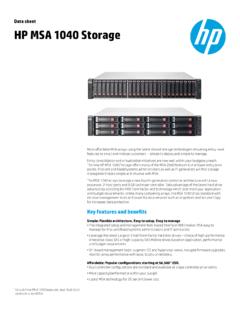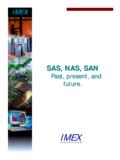Transcription of Paper 143-2011 Using SAS to Move Data betweenServers
1 1 of 12 Paper 143-2011 Using SAS to move data betweenServers John E. Bentley, Wells Fargo Bank, Charlotte NC, USA ABSTRACT In today s complex data management environments, it is not unusual for UNIX servers to be dedicated to a particular department, purpose, or database. As a result, a SAS data analyst often works with multiple servers, each with its own data storage environment. For security reasons, our IT partners often do not make it easy for the servers to talk to one another. So how do we transfer data between servers?
2 SAS provides a number of solutions. This Paper shows ways to use Remote Compute Services and SAS data Transfer Services along with Procs and data steps to move data between servers. Code samples are provided. This presentation is designed for all levels of SAS programmers and is relevant to SAS Enterprise Guide users as well. INTRODUCTION Let s define a situation that s common in financial institutions and probably most other places. We re running SAS on a UNIX server but our data file is on a different UNIX server. This describes a very simple distributed computing environment.
3 There can be variations on our situation but a common theme is that the analytical software is on one server and the data is on another. Other complications might be present, such as SAS may not be on both servers; If SAS is on both servers, the version or product stack might be different; The servers might have different levels of security; and SAS/CONNECT may not be available on one or both servers. Now here s the problem we have to solve: We need a programmatic solution (no manual intervention) that will let our SAS program use the data located on another computer.
4 Maybe that sounds familiar? As usual with SAS, there are multiple ways to solve the problem. Some are more efficient than others in terms of resource usage and clock time, some are more robust than others, but all are probably appropriate for one situation or another. Although we focus in this Paper on moving data sets between servers, the same techniques work very well with flat files. But we will begin with some background on how SAS handles distributed computing environments. From there we will explore specific solutions and get into what everyone really code!
5 There are a few items to note about the code examples. 1. As we all know SAS code is about 98% platform agnostic. The same program runs on Windows, Z/OS, and all the flavors of UNIX. Only operating system-specific items must be changed. The code examples were developed with SAS Using Win/XP and AIX and should work anywhere with at most minor tweaking 2. I m Using the following configuration. Working on a WinXP desktop and Using the SAS Editor. Using SAS/ CONNECT to execute code on an AIX SAS analytical server. data is on another AIX server.
6 Base SAS and SAS/CONNECT are on both servers. 3. Solution 4 addresses situations where SAS/CONNECT isn t on the data server. 4. The code examples don t use macro variables but I strongly encourage you to use them for things like file and data set names and directory paths. WORKING IN A DISTRIBUTED COMPUTING ENVIRONMENT As you might expect, a distributed computing environment calls for a distributed solution. That, is, our program will have to span servers. Depending on the solution we choose, it might execute code on one or both servers, physically move the data from the remote to the local host, or just read the data from the remote host.
7 SAS provides the capabilities or services that allow us to do all of these things remote compute services and remote data services. Cheryl Garner and Stephanie Reinard long ago presented a Paper titled The SAS System: A Complete Client/Server Solution that is so exactly what we need that I m going to just condense and summarize some of the material they present. It is important to understand at least the basics because the implications and side effects of choosing one approach over another can be significant especially when working with massive amounts of data .
8 For a more information about working in multiple server environments, the Garner-Reinard Paper is great starting point. data IntegrationSASG lobalForum2011 2 of 12 SAS/CONNECT SAS/CONNECT has been around since Release and enables SAS programs to run in a distributed environment over two or more computers. Basically, it provides the middleware that allows us to access data on different systems and leverage our computing resources by distributing processing to the most appropriate machine. For it to work though, SAS/CONNECT must be installed on both machines.
9 A local SAS session runs on the computer that initializes the connection--this is the local host. SAS/CONNECT establishes a connection and starts a remote session on a remote host. Viola , we have a client/server environment. But which host is the client and which is the server? The client is the one that originates the processing the server serves the client. But SAS prefers to identify the computers as local and remote. In this Paper I use analytical server and data server, target and source. SAS/CONNECT allows a wide range of problem-solving approaches but it isn t mandatory for solving our particular problem.
10 But it provides the services introduced below that if used together can provide a flexible, robust solution.. For those who are familiar with Using SAS/CONNECT is a desktop-server configuration, it works the same way in a server-server configuration. The primary advantages or SAS/CONNECT is that it provides remote processing and remote data access capabilities. With remote processing, a SAS user on the local host can easily submit code for execution on the remote host by Using the RSUBMIT and ENDRSUBMIT command. All code between RSUBMIT and ENDRSUBMIT executes on the remote host.

















